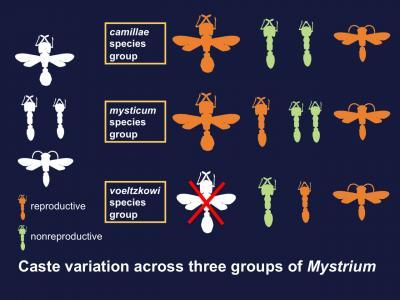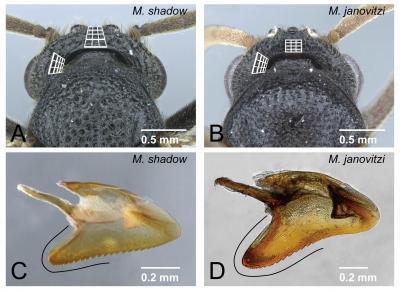Six new species of Dracula ants from the Malagasy region have been discovered and they represent a completely new twist in the typically rigid caste system of ants, where anatomy is typically destiny.
Mystrium species have unique features such as long, spatulate mandibles that snap together (Gronenberg et al. 1998); wingless queens that in some undetermined species are even smaller than workers (Molet et al. 2007); and large, wingless individuals intermediate between workers and queens, which behave like queens (Molet et al. 2012).
Mystrium poses a fiendish problem Mystrium to taxonomists, who identify new and different species.

A living Mystrium species. Credit: Brian Fisher
"The genus Mystrium is the most mysterious group within the bizarre Dracula ants," said California Academy of Sciences post-doctoral fellow Masashi Yoshimura. "Mystrium was a difficult group to identify because of the remarkable variation within each species."
"Mystrium has three different styles in reproduction within a single genus, and the role of an individual in a colony is not always obvious by its appearance. Ants that look similar may be minor workers in one species but queens in another species," said California Academy of Sciences curator of entomology Brian L. Fisher.
"The discovery of the division of females into major and minor forms were the key to solving this complicated puzzle," explained Yoshimura. "We found that all species in Mystrium share a common original components consisting of male, usual large queen, and major and minor workers. Furthermore, the major or minor workers develop as reproductives in some species and even take over queen's position. They are revolutionaries finding in the anatomy-is-destiny world of ants! Taxonomists usually compare the anatomy of ants of the same caste to find differences between species. But in the case of the genus Mystrium, we need to compare individuals from the same original phenotype, not on the their current functional role (caste)," he said.

Different pattern of 'reproductive castes' can be seen in a single genus Mystrium. Credit: Dr. Masashi Yoshimura
The authors have reclassified all species into three subgroups based on the reproductive styles, and developed a new taxonomic framework for this complicated group featuring innovative pictorial keys to the species.
The illustrations include color photographs showing every hair in focus (produced using a computer-assisted method called auto-montage), and drawings for all castes. The paper looks more like a picture book than your average scientific treatise. "I learned drawing techniques from Japanese manga," Yoshimura says.
"To name three of the species we chose words that evoke the air of mystery around this genus, calling them Mystrium labyrinth, Mystrium mirror, and Mystrium shadow." Yoshimura said.

A pictorial key combining full-focused color images and drawing. Credit: AntWeb and Dr. Masashi Yoshimura




Comments